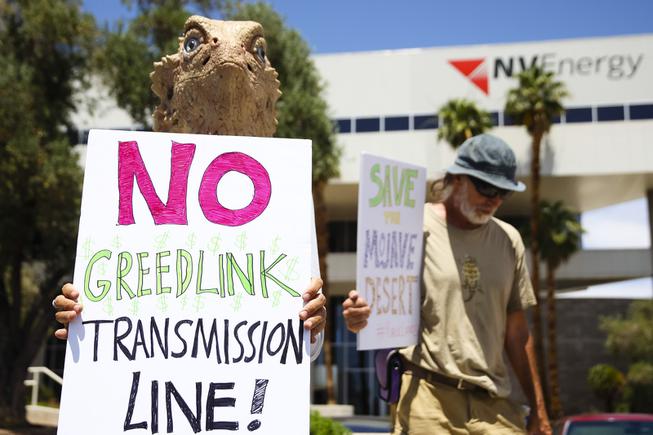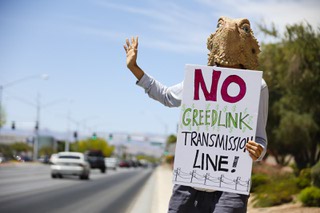
Mojave Green Founder Shannon Salter, wearing a horned lizard mask, protests the NV Energy Greenlink Nevada Transmission Line project Monday, May 16, 2022.
Thursday, May 19, 2022 | 2 a.m.
The Bureau of Land Management started the public comment process this week for the Greenlink West Project, part of a larger initiative by NV Energy to create a “renewable energy highway” around the state.
The Greenlink West project would install a transmission line spanning about 350 miles from Las Vegas to Yerington to connect electric transmission facilities between Northern and Southern Nevada.
The proposal would connect with transmission lines from Yerington to Ely and from Yerington to Reno. One line, from the Ely area to Las Vegas, is already in service, according to NV Energy’s website.
Nevada has an existing transmission system, said NV Energy spokesperson Jennifer Schuricht, but with the increased growth of the state over the last decade, the transmission lines are approaching capacity. Should that level be reached, it would limit NV Energy’s ability to operate the electric grid efficiently, she said. It would also prevent the development of new renewable energy projects.
“Greenlink Nevada will alleviate some of these capacity issues and also open the state for responsible renewable development,” Schuricht said in an email. “Greenlink Nevada is essential to helping Nevada achieve its climate action and de-carbonization goals and increased renewable portfolio standard, moving Nevada closer to a future powered by 100 percent renewable energy and reducing Nevada’s carbon footprint.”
The construction of Greenlink North was driven by Senate Bill 448, legislation passed in the 2021 session that sought to strengthen Nevada’s electric transmission lines and advance the state’s clean energy goals.
BLM will accept public comment on the Greenlink West portion of the project through June 2. Itwill prepare a statement analyzing the environmental impacts associated with the project.
The final environmental impact statement is expected to be published by May 2023, followed by a 30-day protest period and 60-day governor’s review period. A record of decision for the project is scheduled to be completed by July 2023.
The project will require about 469 miles of new transmission lines and substations and will encompass about 13,600 acres of land managed by public entities, in addition to private lands.
If approved, Greenlink West is scheduled to be in service December 2026. Greenlink North, which would span 235 miles from Ely to Yerington, would be next on the list of projects to be approved, and if all goes smoothly would be in service 2028.
The project is expected to generate $690 million in economic activity and create about 4,000 jobs, Schuricht said.
The opposition
Conservationists do not want to see 350 square miles of public land disturbed, and a tribe adjacent to the project says the transmission lines would adversely affect culturally significant land.
Shannon Salter, an activist who has been fighting renewable energy projects slated for deserts in Nevada and California, is worried the project will harm the environment.
The land under the transmission lines will be grated, destroying the ecosystem, Salter said.
About 6% of the energy in transmission lines are lost during the process, “which isn’t a huge amount,” Salter said, “but it’s not nothing.”
Transmission lines are also a fire hazard, she said, as some of the biggest forest fires in California have been caused by transmission lines.
For instance, the transmission lines of Pacific Gas and Electric started the Dixie Fire in northern California last summer, which burned about 1 million acres and 1,300 homes.
Salter’s concerns extend beyond the lines themselves. The project will open the gateway for future energy projects, he reasons and therefore more public land will be affected in the future.
The Timbisha Shoshone Tribe, whose ancestral homelands are in Nevada’s Nye, Mineral and Esmeralda counties as well as California’s Inyo, Kern, San Bernardino and Mono counties, has been a strong opponent to the project.
Barbara Durham, tribal historic preservation officer for the Timbisha Shoshone Tribe, said the area was significant because the tribe had village sites throughout the area. Tribal ancestors once passed through the area to find food, trade objects and find employment.
“We would prefer that they go through already existing areas that have been disturbed,” Durham said, but the tribe is opposed to any route going through Nevada. “No matter which way they go they’re going to find the same thing.”
Schuricht said NV Energy was proposing to put the transmission lines within designated energy corridors or alongside existing transmission.
“The energy corridors were planned and designated as a coordinated effort between the BLM and Department of Energy, which did consider a larger scale planning scenario and included public scoping and input,” Schuricht said in an email. “Several routing options will be evaluated to select a preferred alternative that best minimizes impacts of concern.”
Novel alternative proposed
Salter thinks a better, although more difficult move, would be to put solar canopies on the parking lots throughout Clark County, the rest of the state and ultimately across the country.
“The parking lots are these huge, untapped spaces,” Salter said. “They’re a true wasteland, this forgotten space.”
The solar canopies would serve a dual purpose — it would provide shade for parked cars, and would provide renewable energy without hurting the desert ecosystem, she said. Putting the solar canopies on parking lots would not require extensive environmental reviews, Salter said, as opposed to the projects that are on public land.
Salter’s efforts have turned to a national level. She started a petition to Secretary of the Interior Deb Haaland and President Joe Biden to protect natural ecosystems and move solar to the cities. If half of the parking lots in the U.S. had solar canopies, the amount of energy produced would be equivalent to the renewable energy goals the U.S. has, she said.
She is encouraging people to go to community leaders and landowners and asking them how to get solar on the parking lots. Anybody can go to Walmart, ask to speak to a manager, get connected to the person who owns the land on which the Walmart is located, and say that you want a solar canopy on the parking lot.
The federal government, which is currently providing subsidies to energy companies for solar projects, can provide subsidies to the landowners, she said.
“This is going to improve our living experience in this city,” Salter said.

